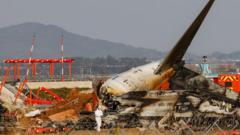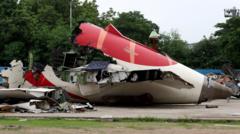Air India, India's premier airline, is dealing with the repercussions of a grave aviation incident that has not only shocked the nation, but raised concerns over the company's operational protocols. The airline announced a temporary reduction of its international flight services by 15% as a direct response to the crash that occurred shortly after takeoff from Ahmedabad, bound for London. The move aims to enhance operational stability and address the chaos resulting from the crash, while minimizing passenger inconvenience.
Passengers have expressed their frustrations about increasing flight cancellations, malfunctioning in-flight devices, and a lack of timely communication from the airline regarding service disruptions. Compounding these issues, the airline has faced additional challenges arising from extended flight routes due to airspace closures over Iran resulting from geopolitical tensions in the region.
The Directorate General of Civil Aviation (DGCA) of India has conducted a series of technical inspections on Air India's fleet of 33 Boeing 787 Dreamliners – the type involved in the crash. While the DGCA has reported no significant safety concerns, it has flagged maintenance-related issues, urging the airline to enhance coordination among its engineering, operations, and ground handling teams. Furthermore, the regulator emphasized the necessity for improved communication with passengers to better relay real-time information about aircraft conditions and availability.
Air India operates a fleet of 128 aircraft, with approximately 1,000 flights per day, connecting various domestic and international locations. One of its key routes is the direct flight from Delhi to New York. As investigations into the crash proceed, the airline faces the dual task of restoring passenger confidence and ensuring the safety and reliability of its operations in a highly competitive aviation sector.
Passengers have expressed their frustrations about increasing flight cancellations, malfunctioning in-flight devices, and a lack of timely communication from the airline regarding service disruptions. Compounding these issues, the airline has faced additional challenges arising from extended flight routes due to airspace closures over Iran resulting from geopolitical tensions in the region.
The Directorate General of Civil Aviation (DGCA) of India has conducted a series of technical inspections on Air India's fleet of 33 Boeing 787 Dreamliners – the type involved in the crash. While the DGCA has reported no significant safety concerns, it has flagged maintenance-related issues, urging the airline to enhance coordination among its engineering, operations, and ground handling teams. Furthermore, the regulator emphasized the necessity for improved communication with passengers to better relay real-time information about aircraft conditions and availability.
Air India operates a fleet of 128 aircraft, with approximately 1,000 flights per day, connecting various domestic and international locations. One of its key routes is the direct flight from Delhi to New York. As investigations into the crash proceed, the airline faces the dual task of restoring passenger confidence and ensuring the safety and reliability of its operations in a highly competitive aviation sector.



















